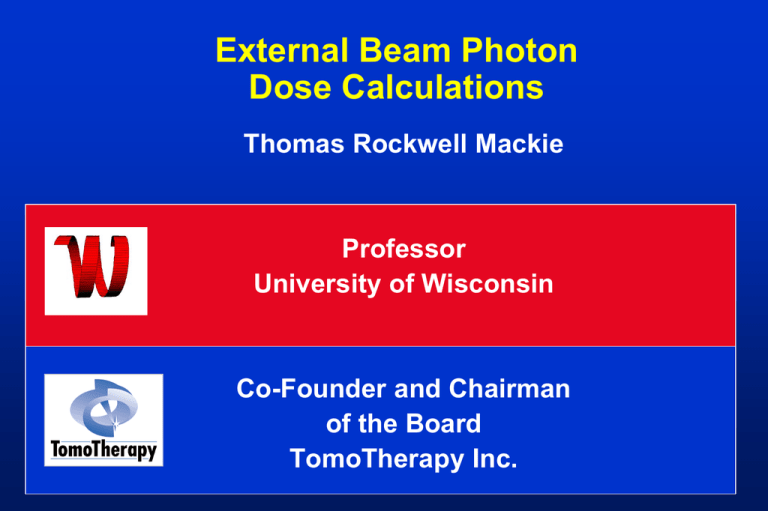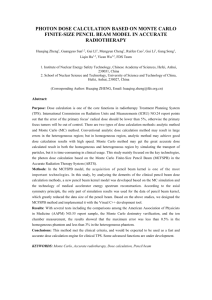External Beam Photon Dose Calculations
advertisement

External Beam Photon Dose Calculations Thomas Rockwell Mackie Professor University of Wisconsin Co-Founder and Chairman of the Board TomoTherapy Inc. Financial Disclosure I am a founder and Chairman of TomoTherapy Inc. (Madison, WI) which is participating in the commercial development of helical tomotherapy. Acknowledgements Michael Sharpe – University of Toronto Colin Field – University of Alberta Milton Woo – University of Toronto Anders Ahnesjo – University of Uppsala Jeff Siebers – Medical College of Virginia Robert Jeraj – University of Wisconsin Jatinder Palta – University of Florida Bruce Curran – Tufts University Isaac Rosen – Lousiana State University Thomas Bortfeld – Harvard University Gary Ezzel – Mayo Clinic, Scotsdale AZ Cedric Yu – University of Maryland Correction-Based Dose Computation • Based on measured dose distributions in a water phantom. • Independent corrections for: – Beam modifiers – Surface contours – Tissue heterogeneities • Based on effective spatial measures such as depth, field boundaries and path lengths. • Heterogeneity corrections that produce less accuracy than having no corrections at all. Model-Based Dose Computation • The convolution/superposition, finite pencil beam and Monte Carlo methods are modelbased dose calculation systems. • Unlike correction-based methods, modelbased methods compute the dose directly in a patient representation. • Model-based dose computations use monitor unit calculations based on beam intensity (e.g., energy fluence) rather than dose in a phantom. • The beam has to be modeled explicitly. What Has to Be Accounted For In Model Based Methods • • • • • • • • • • • Finite source size. Angular distribution of photons. Primary transmission. Extrafocal radiation mainly from the primary collimation and the field flattening filter. Differential hardening of the beam by the field flattening filter. Curved leave ends. Leaf configuration. Tongue and groove effect. Leaf transmission. Electron contamination. Tissue heterogeneities. Modeling the Head Percent of Energy Fluence at Central Axis Direct ~85-95% Primary Collimator ~1-4 % Field Flattening Filter ~5-10 % Issues with the Leaf Shape Potential errors due to leaf shaping source Rounded Edge Tongue & Groove mlc From Bruce Curran Model-Based Methods Are Need for IMRT • IMRT = Summation of small fields • Dose = function(penumbra+leakage+head scatter) • Need accurate treatment head model to get this right IMRT IMRT beam profile XRT XRT beam profile From Michael Sharpe, U. of Toronto IMRT Is About Using Small Fields Intensity pattern possibly unconstrained intensity levels What is delivered Intensity limited to a few discrete intensity levels Adapted from Michael Sharpe, U. of Toronto IMRT Is About Using Small Fields • Accuracy of dose model at small field sizes is a consideration • Convolution-superposition or Monte Carlo desirable Measurement Conventional RTP IMRT From Michael Sharpe, U. of Toronto Extend the Beam Model • Minimum Equivalent Square – Conventional XRT: ~4x4cm2 – IMRT: ~0.5x1cm2 - 2x2cm2 • How to get small field data? – Direct measurement – difficult, errors – Extrapolation of existing data – assumes an underlying physical model – Verify a “golden model” • Any case will have uncertainty; evaluate its impact on a clinical IMRT distribution generated by the inverse planning system Reasons for Drop in Output with Small Field Size • Backscatter into monitor unit from beam defining jaws • Reduced scatter (phantom and head) • Electronic disequilibrium • Obscuration of the source Dose Computation as a Linear System In particular: W1 W2 D1 = M11 W1 + M12 W2 D2 = M21 W1 + M22 W2 In general: M11 M22 M21 D1 M12 D i = ∑ Mij W j or D = MW j D2 Where M is a matrix giving the contribution of dose from each pencil beam. Pencil Beam Convolution D ( x , y, z ) =∫ ∫ ∫ Ψ ( x ', y ', z )K z ( x − x ', y − y ') dxdy From Colin Field, University of Alberta Pencil Beams Generated for Homogeneous Water are Fast • Fast especially for iterative optimization calculations. • The importance of speed grows for more beam directions, finer resolution, and more iterations. • Good for early phases of iteration. • Should do a more accurate calculation for the last iteration and final dose calculation. The Problem with PreComputed Pencil Beams The scattering of rays near the boundary are computed with an environment of water around it when it, in fact, may not always exist. Convolution Equation • The dose distribution can be computed using a convolution equation: D(r) = z vol Dose Distribution µ Ψ (r ′) A(r - r ′) dV ρ Primary Energy Fluence Kernel Derived From Monte Carlo Simulation Source of Radiation Primary Interaction Site r′ r Dose Deposition Site r - r′ Graphical Representation of Dose Computation using Convolution = x Primary Energy Fluence Distribution Convolution Kernel (from MC Simulation) Dose Distribution Adapted From Colin Field Comparison of Two Kernel Sets 5 MeV 20 MeV Mackie et al 1988 Chui and Mohan 1986 Mackie et al 1988 PMB 33:1-20 Spherical Shell Summed Kernels Mackie et al 1988 PMB 33:1-20 0.5 MeV Kernels Describe Photon Scattering and Electron Transport 10 cm x 10 cm Parallel Beam In Water 50 MeV Ahnesjo and Asparadakis, 1999 Phys Med Biol 44:R99-R155 Adjusting the Spectra to Get Agreement with Measurements 0.10 180 Exp. Conv.Sup. Spec. 1 Conv.Sup. Spec. 2 160 0.08 Spec. 1 Spec. 2 140 0.06 120 PDD dφ/dE (a.u.) Field Size 1.12cm 0.04 100 80 60 0.02 40 0.00 0 1 2 3 4 5 Energy (MeV) 6 7 8 20 0.0 2.5 5.0 7.5 10.0 12.5 15.0 depth (cm) The depth-dose curve is very forgiving with respect to spectral shape. Source of Photons for a Conventional Linac 85 % Percent of Total 4 % 10 % Liu HH et al. Med. Phys. 24, 1960-1974 (1997). Scatter Fraction from the Flattening Filter Ahnesjo 1994 Med. Phys. 21;1227-1235 MC Simulation of the Relative Fluence as a Function of Radius in the Beam 10 MV Varian Liu HH et al. Med. Phys. 24, 1960-1974 (1997). MC Simulation of the Radial Dependence of Mean Energy 10 MV Varian Liu HH et al. Med. Phys. 24, 1960-1974 (1997). MC Simulation of the Radial Dependence of Mean Energy 6 MV Elekta Fippel et al 2003 Med. Phys. 30:301-311 Tomotherapy Off-axis Spectral Dependence 0.040 0.035 0-5 cm 5-10 cm 10-15 cm 15-20 cm 0.025 0-5 cm 5-10 cm 10-15 cm 15-20 cm 0.020 0.01 0.015 Photon spectrum Photon spectrum 0.030 0.010 0.005 1E-3 0.000 0 1 2 3 4 Energy [MeV] 5 6 7 0 1 2 3 4 Energy [MeV] Tomotherapy has little off-axis spectral dependence because it has no flattening filter; favorable for TPS From Jeraj et al Med. Phys. 396-404, (2004). 5 6 7 Modeling the Energy Fluence from Measurements in Air Comparison of an energy fluence model and the dose in air. Used to model energy fluence for MC simulation but also could be used for the convolution calculations. Fippel et al 2003 Med. Phys. 30:301-311 Effect of Kernel Hardening No Kernel Hardening Kernel Hardening Monte Carlo Liu HH et al Med. Phys. 24, 1729-1741 (1997). Depth-Dose at 85 cm SSD for 1 cm Beam Width Measurement Dose Pinnacle Model Depth (cm) Percent Depth-Dose (Normalized to Dose at 10 cm Depth) Tomotherapy Beam Transverse Unmodulated Dose Profiles Tomotherapy Beam Calculations using the convolution/superposition method on the TomoTherapy HI-ART II treatment planning system. Longitudinal (Z-axis) Dose Profiles Tomotherapy Beam Superposition Equation D(r) = z ⋅ r - r ′) dV T( ρ r ′ ⋅ r ′) A( ρ r-r ′ vol Dose Distribution Source of Radiation r Dose Deposition Site Primary Interaction Site r′ r - r′ The Primary Terma Depends on the Radiological Pathlength of the Primary Ray The Kernel is Scaled w.r.t. the Radiological Pathlength Between the Primary Photon Interaction Site and the Dose Deposition Site Superposition Assumptions • Primary Photon Interaction Site Primary Photon First Scattered Photon Dose Deposition Site • • • Ray tracing from the primary photon interaction site to the dose deposition site assumes that that is the relevant path. This correctly accounts for perturbation in first scatter photons which is the dominant scatter. It is not a bad approximation for electrons. The approximation is worse for 2nd and higher order scatter. No Kernel Stretching muscle ρ=1 gr/cm3 lung ρ=0.25 gr/cm3 Image from Nikos Papanikolaou, Ph.D. Heterogeneities: Kernel Stretching muscle ρ=1 gr/cm3 lung ρ=0.25 gr/cm3 Image from Nikos Papanikolaou, Ph.D. Homogeneous Vs. Heterogeneous Heterogeneous Terma But Homogeneous Electron Transport and Scatter Homogeneous Terma, Electron Transport and Scatter Non-Invariance of Convolution Kernels in Inhomogeneous Phantoms Density Scaled Kernel Monte Carlo Computation for Hetereogeneous Situation From Woo and Cunningham Superposition Result In low density materials like lung (or cork) the electrons and scattered photons travel much farther. To first order, radiation penetration is inversely proportional to electron density. From Anders Ahnesjo Small Field Sizes and Electronic Disequilibrium 6 MV Direct Component Only Each Beam Normalized Separately to Dmax at the Central Axis Dose per Incident Energy Fluence As a Function of Field Diameter A=Adipose, M=Muscle, B=Bone, L=Lung 4 MV, Parallel Beam Ahnesjo and Asparadakis, 1999 Phys Med Biol 44:R99-R155 Sweeping Contamination Electrons With an Electromagnet B Electrons Swept Out of the Page and Positrons Swept Into the Page From Jursinic and Mackie PMB 41:1499-1509 Buildup Curves With and Without Magnetic Field From Jursinic and Mackie PMB 41:1499-1509 Surface Dose as a Function of Magnetic Field Strength Each Beam Normalized Separately to the Dmax at the Central Axis with No Magnetic Field Photon Backscatter From Jursinic and Mackie PMB 41:1499-1509 Ionization Attributable to Electron Contamination Electron Contamination Depth-Dose Curve Has a Small Buildup at Higher Energies From Jursinic and Mackie PMB 41:1499-1509 Electron Contamination Modeling Electron Contamination Done as part of the modeling process – e contamination dose is modeled as a modified exponential curve. Convolution Superposition as Done in Pinnacle 1. 2. 3. 4. Model the incident fluence as it exits linac head. Project this fluence through the density representation of the patient (CT data) – compute TERMA. 3D convolution/superposition of TERMA and point kernel (ray tracing) Electron contamination added to dose distribution at the end. Monte Carlo Calculation • Explicitly transport individual photons through the head and patient. • Geometry and radiation physics is the model. • EGS4 and BEAM, MCNP, Geant, and Penelope are available for research. • Models are clinically available (e.g. Monaco from CMS) Head and Neck Case Histogram of Monte Carlo - Superposition Monte Carlo Superposition Monte Carlo From Jeff Siebers Monte Carlo Lung Case Histogram of Monte Carlo - Superposition Monte Carlo - Superposition From Jeff Siebers Comparisons for an IMRT Case Monte Carlo Convolution/superposition Pencil Beam From Robert Jeraj, University of Wisconsin Errors in Optimized Planning Convolution/superposition dose calculation Error [% Dmax] Tumour Lung Systematic − 0.1 ± 2 − 1± 1 2-5 1-4 Tumour Lung +8±3 +6±5 3-5 6-7 Convergence Pencil beam dose calculation Error [% Dmax] Systematic Convergence Convolution/superposition dose calculation is acceptable, pencil beam dose calculation may not always be. MU Calculations For Model Based Systems MU = Ψ (SPD, r) MU Dpresc (P) D / MU (P) SPD r D D Ψ (P) = (P) (SPD, r) MU Ψ MU Computed Directly Beam Output P Beam Output for ModelBased Systems • • Establish Energy Fluence/MU By Measurement in a Phantom. SPD r But the Result is Phantom Independent. Ref Ψ D (SPD, r) = (Ref) MU MU Beam Output Measured Which is Phantom Independent Ψ (SPD, r) MU D (Ref) Ψ Computed for Same Condition as Measurement Extended Phantom Concept and Dose Reconstruction Will Monte Carlo Take Over? • For few-field IMRT Monte Carlo is slower than the convolution/superposition method. • The computation time for Monte Carlo is nearly independent of the number of beam directions. • The Monte Carlo method is only slightly more accurate for photon beams. • It will be easier to take into account IMRT delivery geometries (e.g. collimators). Summary • The convolution method is a deterministic calculation using results of Monte Carlo simulation. • Beam characterization can be performed using Monte Carlo simulation. • The superposition method, a variant of the convolution method, and predicts dose within a few percent of the Monte Carlo method and about an order of magnitude faster for few calculation fields. • Energy fluence calibration is more appropriate for model-based dose calculation systems.


